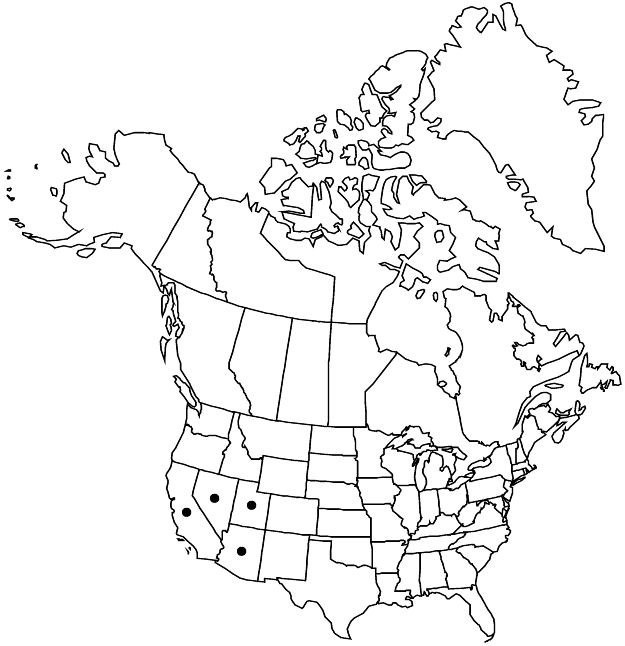Difference between revisions of "Phoradendron californicum"
J. Acad. Nat. Sci. Philadelphia, n. s. 1: 185. 1848.
FNA>Volume Importer |
FNA>Volume Importer |
||
| Line 12: | Line 12: | ||
|name=Phoradendron californicum var. distans | |name=Phoradendron californicum var. distans | ||
|authority=Trelease | |authority=Trelease | ||
| − | }}{{Treatment/ID/Synonym | + | }} {{Treatment/ID/Synonym |
|name=P. californicum var. leucocarpum | |name=P. californicum var. leucocarpum | ||
|authority=(Trelease ex Munz & I. M. Johnston) Jepson | |authority=(Trelease ex Munz & I. M. Johnston) Jepson | ||
| Line 30: | Line 30: | ||
|elevation=0–1800 m. | |elevation=0–1800 m. | ||
|distribution=Ariz.;Calif.;Nev.;Utah;Mexico (Baja California;Baja California Sur;Sinaloa;Sonora). | |distribution=Ariz.;Calif.;Nev.;Utah;Mexico (Baja California;Baja California Sur;Sinaloa;Sonora). | ||
| − | |discussion=<p>Phoradendron californicum, like P. juniperinum, bears only scalelike leaves, but this character has evolved independently in the two species (V. E. T. M. Ashworth 2000). Phoradendron californicum differs by its different hosts (legumes versus conifers) and inflorescences with more than one fertile internode. Molecular data indicate that P. californicum is not part of the acataphyllous Boreales group in the sense of W. Trelease (1916) but allied with cataphyllous tropical species (Ashworth). Varieties and host races have been proposed but these are not recognized in the most recent monograph of the genus (J. Kuijt 2003). In addition to its primary hosts, Prosopis, Senegalia, and Vachellia, Phoradendron californicum has also been recorded from a number of other hosts including Condalia, Dalea, Ebenopsis, Havardia, Larrea, Olneya, Parkinsonia, and sometimes is hyperparasitic on Psittacanthus.</p> | + | |discussion=<p><i>Phoradendron californicum</i>, like <i>P. juniperinum</i>, bears only scalelike leaves, but this character has evolved independently in the two species (V. E. T. M. Ashworth 2000). <i>Phoradendron californicum</i> differs by its different hosts (legumes versus conifers) and inflorescences with more than one fertile internode. Molecular data indicate that <i>P. californicum</i> is not part of the acataphyllous Boreales group in the sense of W. Trelease (1916) but allied with cataphyllous tropical species (Ashworth). Varieties and host races have been proposed but these are not recognized in the most recent monograph of the genus (J. Kuijt 2003). In addition to its primary hosts, Prosopis, Senegalia, and Vachellia, <i>Phoradendron californicum</i> has also been recorded from a number of other hosts including <i>Condalia</i>, Dalea, Ebenopsis, Havardia, <i>Larrea</i>, Olneya, Parkinsonia, and sometimes is hyperparasitic on Psittacanthus.</p> |
|tables= | |tables= | ||
|references= | |references= | ||
| Line 54: | Line 54: | ||
|publication year=1848 | |publication year=1848 | ||
|special status= | |special status= | ||
| − | |source xml=https://jpend@bitbucket.org/aafc-mbb/fna-data-curation.git/src/ | + | |source xml=https://jpend@bitbucket.org/aafc-mbb/fna-data-curation.git/src/8f726806613d60c220dc4493de13607dd3150896/coarse_grained_fna_xml/V12/V12_1013.xml |
|genus=Phoradendron | |genus=Phoradendron | ||
|species=Phoradendron californicum | |species=Phoradendron californicum | ||
Revision as of 14:42, 18 September 2019
Subshrubs, pendent, 1–5(–20) dm, dioecious. Stems grayish green to reddish green (in full sun), densely hairy, hairs silvery white, closely appressed, becoming glabrate; internodes terete, 10–20(–30) × 1–1.7(–2.5) mm. Leaves grayish green, scalelike; blade triangular, 1.5–3 mm, apex acute; basal phyllotaxy transverse or median. Staminate inflorescence 5–25 mm, peduncle with 1(–2) internodes, each 0.5–3 mm; fertile internodes (1–)2–3(–5), each 6–14-flowered, biseriate, flowers 1–3 per column. Pistillate inflorescences 5–10 mm, elongating in fruit; peduncle with 1(–2) internodes, each 0.5–3 mm; fertile internodes (1–)2–4(–6), each 2-flowered, flowers 1 per bract. Flowers: petals 3(–4), 1–2 mm. Berries white, translucent yellowish, pinkish, orange-red, or maroon, globose, 3–6 × 3–6 mm, glabrous. 2n = 28.
Phenology: Flowering late fall–winter.
Habitat: Desert scrub or washes with mesquite or acacia.
Elevation: 0–1800 m.
Distribution

Ariz., Calif., Nev., Utah, Mexico (Baja California, Baja California Sur, Sinaloa, Sonora).
Discussion
Phoradendron californicum, like P. juniperinum, bears only scalelike leaves, but this character has evolved independently in the two species (V. E. T. M. Ashworth 2000). Phoradendron californicum differs by its different hosts (legumes versus conifers) and inflorescences with more than one fertile internode. Molecular data indicate that P. californicum is not part of the acataphyllous Boreales group in the sense of W. Trelease (1916) but allied with cataphyllous tropical species (Ashworth). Varieties and host races have been proposed but these are not recognized in the most recent monograph of the genus (J. Kuijt 2003). In addition to its primary hosts, Prosopis, Senegalia, and Vachellia, Phoradendron californicum has also been recorded from a number of other hosts including Condalia, Dalea, Ebenopsis, Havardia, Larrea, Olneya, Parkinsonia, and sometimes is hyperparasitic on Psittacanthus.
Selected References
None.